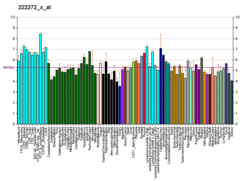SCIN
Scinderin (also known as adseverin) is a protein that in humans is encoded by the SCIN gene.[5] Scinderin is an actin severing protein belonging to the gelsolin superfamily.[6] It was discovered in Dr. Trifaro's laboratory at the University of Ottawa, Canada. Secretory tissues are rich in scinderin. In these tissues scinderin, a calcium dependent protein, regulates cortical actin networks. Normally secretory vesicles are excluded from release sites on the plasma membrane by the presence of a cortical actin filament network. During cell stimulation, calcium channels open allowing calcium ions to enter the secretory cell. Increase in intracellular calcium activates scinderin with the consecuent actin filament severing and local dissociation of actin filament networks. This allows the movement of secretory vesicles to release sites on the plasma membrane.
References
- 1 2 3 GRCh38: Ensembl release 89: ENSG00000006747 - Ensembl, May 2017
- 1 2 3 GRCm38: Ensembl release 89: ENSMUSG00000002565 - Ensembl, May 2017
- ↑ "Human PubMed Reference:".
- ↑ "Mouse PubMed Reference:".
- ↑ "Entrez Gene: SCIN scinderin".
- ↑ Ghoshdastider, U; Popp, D; Burtnick, L. D.; Robinson, R. C. (2013). "The expanding superfamily of gelsolin homology domain proteins". Cytoskeleton. 70 (11): 775–95. doi:10.1002/cm.21149. PMID 24155256.
Further reading
- Rodríguez Del Castillo A; Vitale ML; Trifaró JM (1992). "Ca2+ and pH determine the interaction of chromaffin cell scinderin with phosphatidylserine and phosphatidylinositol 4,5,-biphosphate and its cellular distribution during nicotinic-receptor stimulation and protein kinase C activation". J. Cell Biol. 119 (4): 797–810. doi:10.1083/jcb.119.4.797. PMC 2289683. PMID 1331119.
- Rodríguez Del Castillo A; Vitale ML; Tchakarov L; Trifaró JM (1992). "Human platelets contain scinderin, a Ca(2+)-dependent actin filament-severing protein". Thromb. Haemost. 67 (2): 248–51. PMID 1621245.
- Lueck A; Brown D; Kwiatkowski DJ (1999). "The actin-binding proteins adseverin and gelsolin are both highly expressed but differentially localized in kidney and intestine". J. Cell Sci. 111. ( Pt 24): 3633–43. PMID 9819354.
- Zunino R, Li Q, Rosé SD, et al. (2001). "Expression of scinderin in megakaryoblastic leukemia cells induces differentiation, maturation, and apoptosis with release of plateletlike particles and inhibits proliferation and tumorigenesis". Blood. 98 (7): 2210–9. doi:10.1182/blood.V98.7.2210. PMID 11568009.
- Nagase T; Kikuno R; Ohara O (2002). "Prediction of the coding sequences of unidentified human genes. XXI. The complete sequences of 60 new cDNA clones from brain which code for large proteins". DNA Res. 8 (4): 179–87. doi:10.1093/dnares/8.4.179. PMID 11572484.
- Lejen T; Pene TD; Rosé SD; Trifaró JM (2002). "The role of different Scinderin domains in the control of F-actin cytoskeleton during exocytosis". Ann. N. Y. Acad. Sci. 971 (1): 248–50. doi:10.1111/j.1749-6632.2002.tb04469.x. PMID 12438125.
- Strausberg RL, Feingold EA, Grouse LH, et al. (2003). "Generation and initial analysis of more than 15,000 full-length human and mouse cDNA sequences". Proc. Natl. Acad. Sci. U.S.A. 99 (26): 16899–903. doi:10.1073/pnas.242603899. PMC 139241. PMID 12477932.
- Hillier LW, Fulton RS, Fulton LA, et al. (2003). "The DNA sequence of human chromosome 7". Nature. 424 (6945): 157–64. doi:10.1038/nature01782. PMID 12853948.
- Ota T, Suzuki Y, Nishikawa T, et al. (2004). "Complete sequencing and characterization of 21,243 full-length human cDNAs". Nat. Genet. 36 (1): 40–5. doi:10.1038/ng1285. PMID 14702039.
- Bouwmeester T, Bauch A, Ruffner H, et al. (2004). "A physical and functional map of the human TNF-alpha/NF-kappa B signal transduction pathway". Nat. Cell Biol. 6 (2): 97–105. doi:10.1038/ncb1086. PMID 14743216.
- Ehre C, Rossi AH, Abdullah LH, et al. (2005). "Barrier role of actin filaments in regulated mucin secretion from airway goblet cells". Am. J. Physiol., Cell Physiol. 288 (1): C46–56. doi:10.1152/ajpcell.00397.2004. PMID 15342343.
- Gerhard DS, Wagner L, Feingold EA, et al. (2004). "The status, quality, and expansion of the NIH full-length cDNA project: the Mammalian Gene Collection (MGC)". Genome Res. 14 (10B): 2121–7. doi:10.1101/gr.2596504. PMC 528928. PMID 15489334.
- Otsuki T, Ota T, Nishikawa T, et al. (2007). "Signal sequence and keyword trap in silico for selection of full-length human cDNAs encoding secretion or membrane proteins from oligo-capped cDNA libraries". DNA Res. 12 (2): 117–26. doi:10.1093/dnares/12.2.117. PMID 16303743.
- Kimura K, Wakamatsu A, Suzuki Y, et al. (2006). "Diversification of transcriptional modulation: large-scale identification and characterization of putative alternative promoters of human genes". Genome Res. 16 (1): 55–65. doi:10.1101/gr.4039406. PMC 1356129. PMID 16344560.




